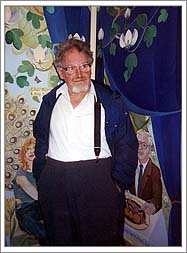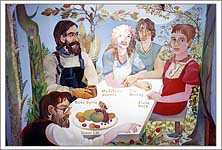Negotiations of Genre in the Short Fiction
of Alasdair Gray
8th International Conference on the Short
Story in English, Alcalá de Henares, October 28-31, 2004
[SLIDES]
This paper examines textual
and
paratextual markers of genre in three collections of short fiction by
Alasdair
Gray. Gray is well known for his lavish use of illustrations, which
normally
feature his own artwork, helping to add a rich dialogism to his text.
However,
his whole use of paratext such as prefaces, marginalia, foot- and
endnotes,
titles and subtitles, epigraphs etc. indicates an acute awareness on
his part
of how such paratext helps construct genre. Following Gerard Genette’s
cataloguing of the forms and functions of paratextuality and
archetextuality, I
propose to sketch out a contribution to the field of short story
poetics,
building on insights highlighted by Gray’s ludic practice.
 Alasdair Gray
Alasdair Gray
Gray
uses multiple generic markers in his titles and subtitles: Unlikely
Stories, Mostly (1983); Ten Tales Tall and True: Social
Realism, Sexual
Comedy, Science Fiction, Satire (1993); The Ends of Our
Tethers: Sorry
Stories by Alasdair Gray (2003). Often, in fact, these markers are
set up
by the title and then undercut by the subtitles. Internally in the
stories a
mixture of conventions and forms from other fields of writing, such as
historiography, the essay, journalism, autobiography and other
non-fiction
modes, creates a rich melange of contexts, paradoxically evoked as
fictional by
Gray’s ‘stories’. He further creates a tapestry of fictional modes,
borrowing
tropes from fantasy, science fiction and pornography in his story (and
novel)
practice. The end result is a neo-baroque/post-modern cross-aesthetic
short
fiction, which when packaged as collections (one appearing each decade
since
the 1980s) packs a punch not normally associated with short story
sequences. I
propose to read Gray’s short story collection practice as emblematic of
a new,
postmodern venture into packaging and theming of short story sequences
as an
ideal medium for social commentary, satire and political critique.

Mural in The Ubiquitous Chip


